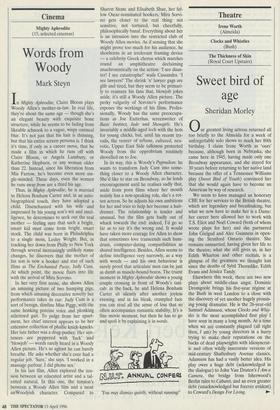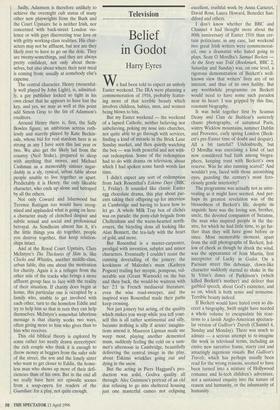Theatre
Irene Worth (Almeida)
Clocks and Whistles (Bush)
The Thickness of Skin (Royal Court Upstairs)
Sweet bird of age
Sheridan Morley
Our greatest living actress returned all too briefly to the Almeida for a week of unforgettable solo shows to mark her 80th birthday. I claim Irene Worth as 'ours' because, although born in Nebraska, she came here in 1945, having made only one Broadway appearance, and she stayed for 30 years before returning to her native land because the offer of a Tennessee Williams play (Sweet Bird of Youth) convinced her that she would again have to become an American by way of research.
We seem to have managed an honorary CBE for her services to the British theatre, which are legendary and breathtaking, but what we now have to make her is a Dame: her career here allowed her to work with T.S. Eliot and Noel Coward (both of whom wrote plays for her) and she partnered John Gielgud and Alec Guinness in open- ing the Stratford Ontario theatre. She remains unmarried, having given her life to the theatre; what she still gives us, in her Edith Wharton and other recitals, is a glimpse of the greatness we thought lost since the deaths of Sybil Thorndike, Edith Evans and Jessica Tandy.
Elsewhere this week, there are two new plays about middle-class angst. Dominic Dromgoole brings his five-year regime at the Bush in west London to a close with the discovery of yet another hugely promis- ing young dramatist. He is the 26-year-old Samuel Adamson, whose Clocks and Whis- tles is the most accomplished first play I have seen in many a long month. At a time when we are constantly plagued (all right then, I am) by young directors in a hurry trying to make their reputations on the backs of dead playwrights with idiosyncrat- ic and often wildly inaccurate versions of mid-century Shaftesbury Avenue classics, Adamson has had a vastly better idea. His play owes a huge debt (acknowledged in the dialogue) to John Van Druten's I Am a Camera, the bridge from Isherwood's Berlin tales to Cabaret, and an even greater debt (unacknowledged but forever evident) to Coward's Design For Living. s■ Sadly, Adamson is therefore unlikely to achieve the overnight cult status of many other new playwrights from the Bush and the Court Upstairs: he is neither Irish, nor concerned with back-street London vio- lence or with gays discovering true love or with gritty working-class realities. His char- acters may not be affluent, but nor are they likely ever to have to go on the dole. They are twenty-somethings, and they are always pretty confident, not only about them- selves, but also about where their next meal is coming from: usually at somebody else's expense.
The central character, Henry (mournful- ly well played by John Light), is, admitted- ly, a gay publisher locked so tight in his own closet that he appears to have lost the key, and yes, we may as well at this point add Simon Gray to the list of Adamson's creditors.
Around Henry there is, first, the Sally Bowles figure, an ambitious actress ruth- lessly and starrily played by Kate Beckin- sale, whose bid for real stardom here is as strong as any I have seen this last year or two. We also get the likely lad from the country (Neil Stuke), prepared to sleep with anything that moves, and Michael Cashman as a memorably sinister sugar- daddy in a sly, cynical, urban fable about people unable to live together or apart. Predictably it is Henry, the only likeable character, who ends up alone and betrayed by all the others.
Not only Coward and Isherwood but Terence Rattigan too would have recog- nised and applauded what is going on here: a character study of clenched despair and subtle sexual and social and professional betrayal. As Sondheim almost has it, it's the little things you do together, people you destroy together, that keep relation- ships intact.
And at the Royal Court Upstairs, Clare McIntyre's The Thickness of Skin is, like Clocks and Whistles, another middle-class, urban fable, this one about the motivation for charity. Again it is a refugee from the other side of the tracks who brings a more affluent group face to face with the reality of their situation. If charity does begin at home, this particular one is occupied by a family who, unable to get involved with each other, turn to the homeless Eddie and try to help him so that in turn they can help themselves. McIntyre's somewhat laborious message is that charity works two ways, often giving more to him who gives than to him who receives.
This old biblical theory is explored by some rather too neatly drawn stereotypes: the rich couple who think it is enough to throw money at beggars from the safer side of the street, the son and the lonely sister who want to get closer to Eddie, the home- less man who shows up more of their defi- ciencies than of his own. But in the end all we really have here are episodic scenes from a soap-opera for readers of the Guardian: for a play, not quite enough.



































































 Previous page
Previous page